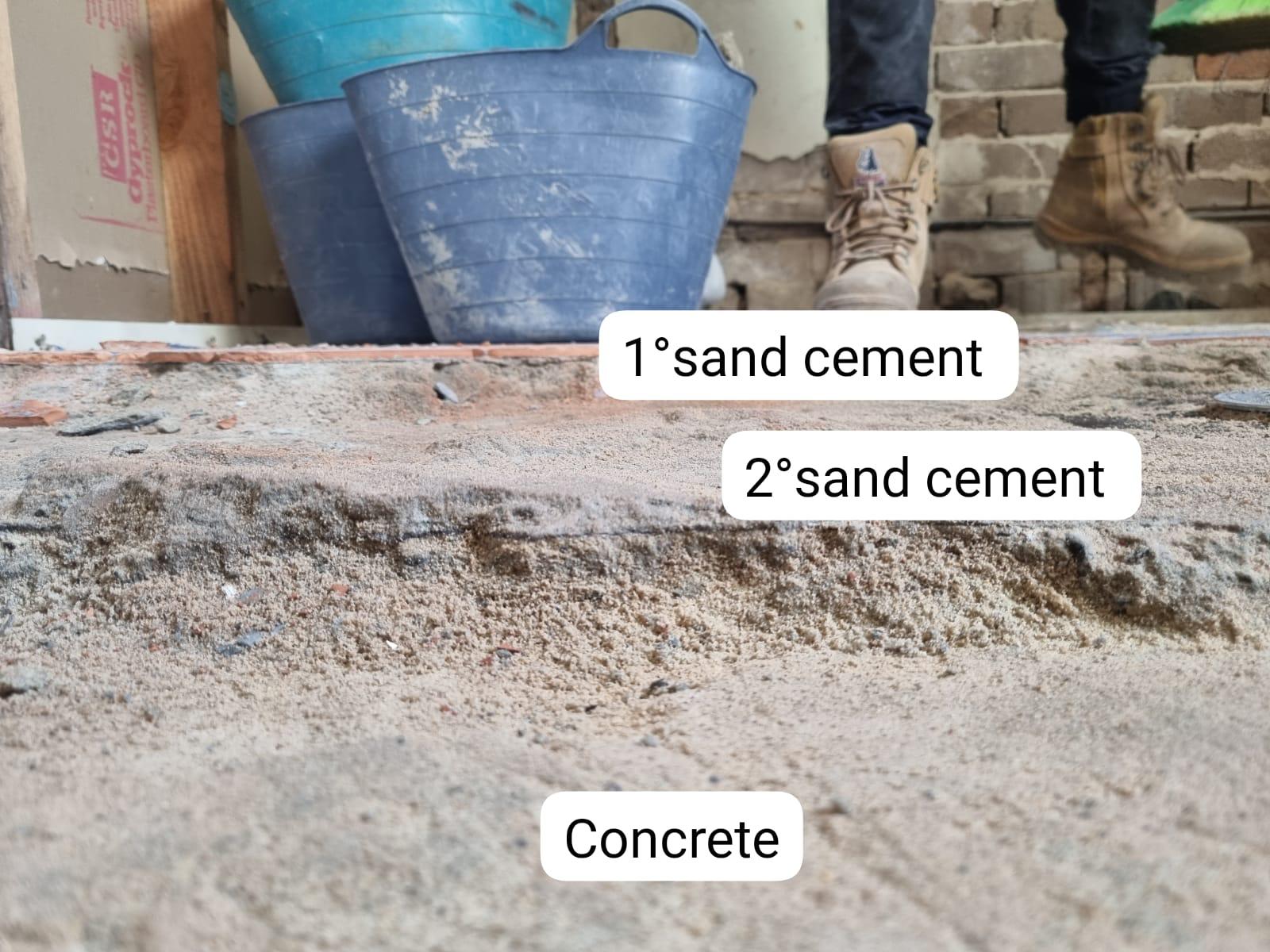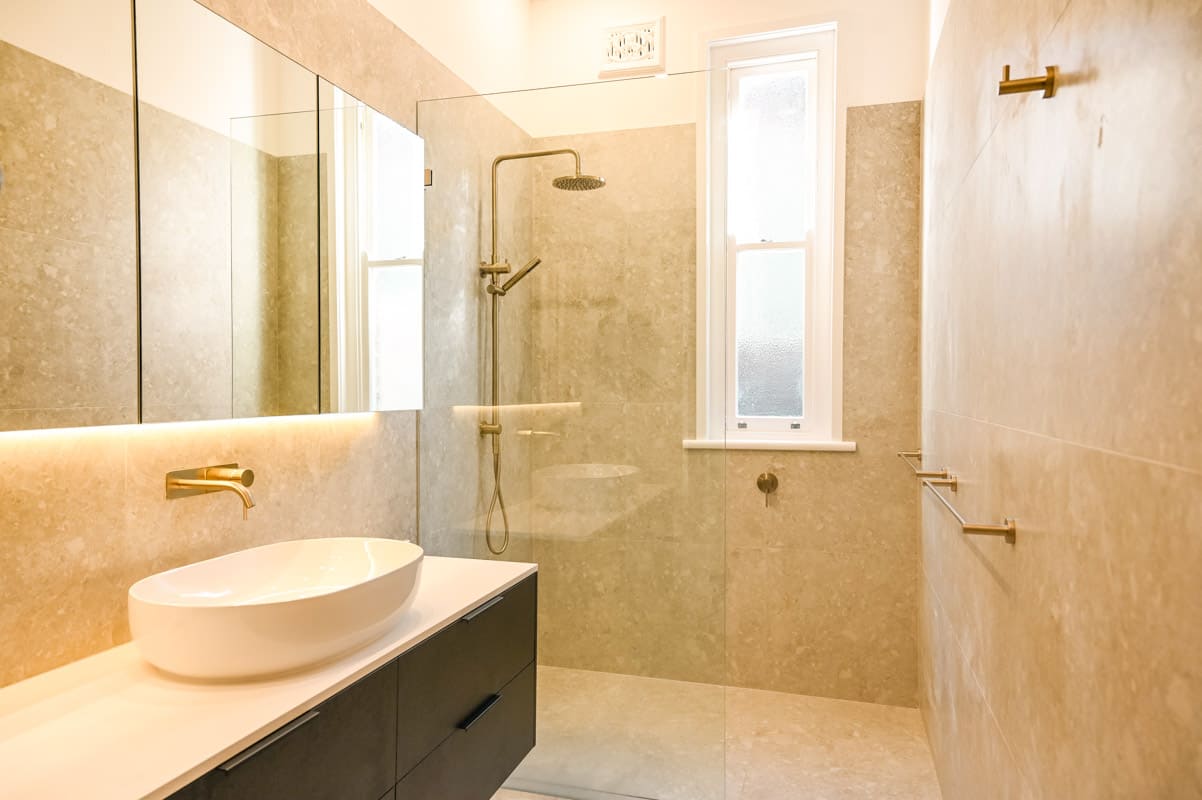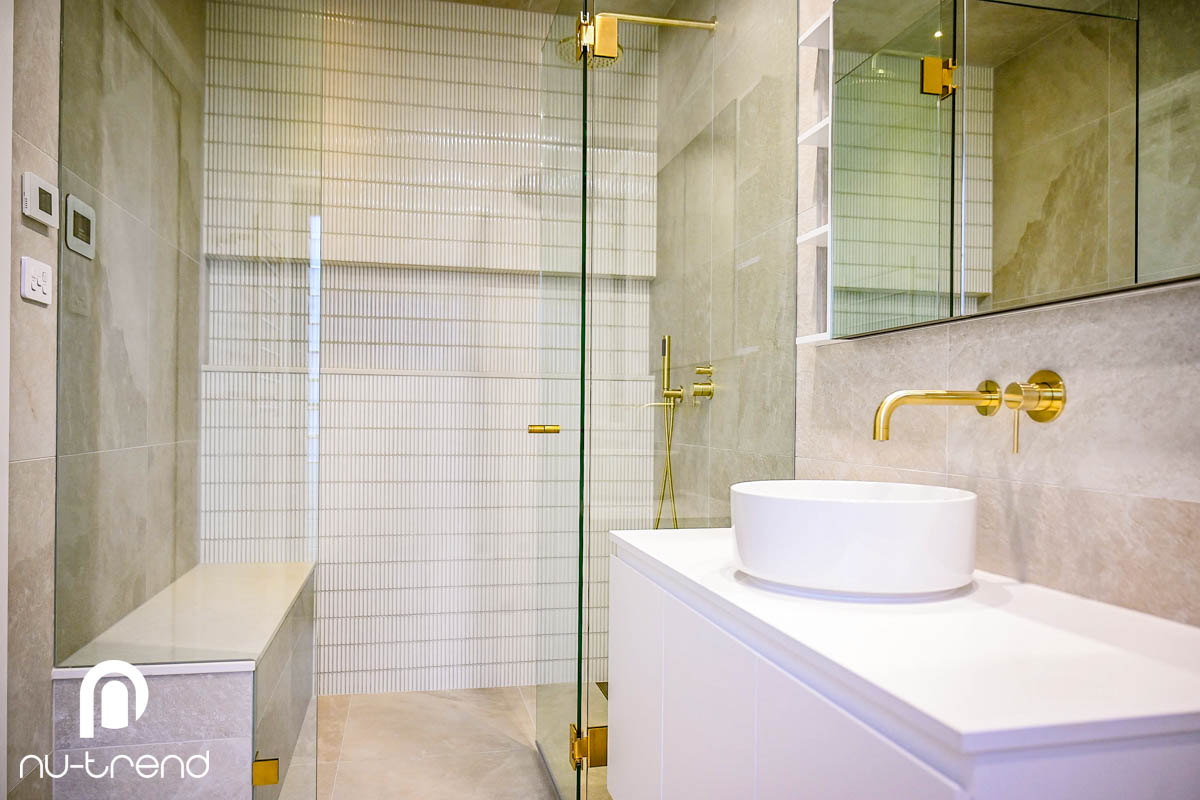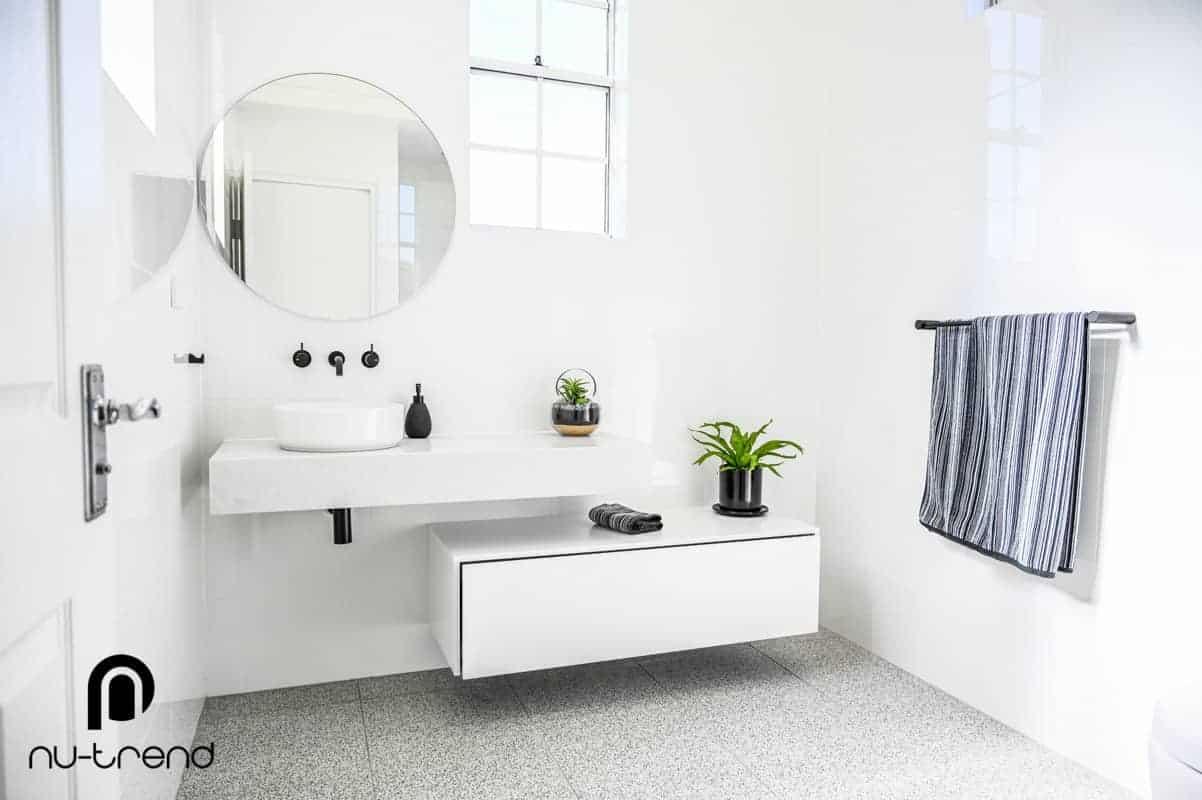You can't renovate a bathroom in Sydney with a damaged concrete slab

We started the demolition for a bathroom renovation in Beverly Hills in Sydney and discovered the worse concrete slab foundation that we have ever seen. We are not kidding, we have never in our lives seen such a shonky looking concrete slab in an existing bathroom.
- There was tiling that had been laid over the existing tiling.
- The screed was damaged.
- The slab was damaged and it had been poured over the top of loose back fill which had fake grass, bricks and other debris just covered over.
We have absolutely no idea how it has all stayed together and kept the room in place for so long. Although guess what? The reason this bathroom is getting renovated is because the water proofing had failed, so there were water leaks that had to get repaired and we very quickly found the reason for it all. The room had no solid foundation and the concrete slab had to be completely removed and replaced.
We couldn’t even determine the full extent of the damage until everything was removed and we could see everything that was under the foundation of the room. This meant it would cost extra in labour, more demolition costs and delays in the project completion timeline. The room is actually so dangerous to even walk in because over time it has the potential to crack and disintegrate as someone walks on it.
How do you know if your concrete slab is damaged in your bathroom?
Detecting damage in a concrete slab, especially in a bathroom, is crucial for ensuring structural safety and preventing potential water damage. Some signs and methods to identify damage in a concrete slab might include;
Visual Inspection:
- Cracks: These can be hairline cracks, which may not pose an immediate threat, or wider cracks that may indicate serious damage.
- Spalling: This refers to flaking or chipping on the concrete’s surface. Over time, water and moisture can cause the concrete’s surface layer to deteriorate, resulting in spalling.
- Discolouration: Stains or spots on the slab may indicate water penetration or other forms of damage.
Physical Inspection:
- Unevenness: If the floor feels uneven underfoot, it could be a sign of the slab settling or heaving due to soil movement underneath.
- Hollow sounds: Tapping on the slab in various locations using a mallet can reveal hollow areas beneath the concrete, which could be indicative of voids or delamination.
Water Damage:
- Pooling: In a bathroom, if water is pooling in certain areas and not draining properly, it could be due to unevenness in the slab.
- Efflorescence: This is a white, powdery residue that can appear on the surface of concrete. It’s caused by soluble salts in the concrete being brought to the surface by moisture. This indicates the presence of moisture within the slab.
Functional Issues:
- Door Misalignment: If doors near or within the bathroom are suddenly misaligned or difficult to open or close, it could indicate that the slab has moved or settled.
External Factors:
- Plumbing Leaks: Persistent plumbing leaks can damage a concrete slab over time. If you suspect a leak, it’s essential to address it promptly.
- Tree Roots: In some cases, especially if the bathroom is on the ground floor and near large trees, roots can push up against the slab, causing it to crack or lift.
Professional Assessment:
- Moisture Meter: A professional can use a moisture meter to detect excessive moisture in the slab, which might be indicative of damage.
- Core Sampling: Taking a core sample of the concrete slab can help in assessing the internal health of the slab.
- Ground Penetrating Radar (GPR): This tool can help detect voids or anomalies beneath the surface of the concrete slab.
If you suspect any damage, or your bathroom renovator discovers any, especially if it’s extensive, it’s always recommended to consult with a structural engineer or a specialist to assess the condition of the slab and recommend remedial actions.
What did we discover in this bathroom?
For this bathroom in Beverly Hills, once we stripped the tiling from the floors and walls of the bathroom we could see the poor state of the surface of the concrete slab. Sometimes it might just be uneven or have a few cracks from movement of the foundations, but this one was completely different.
As we mentioned there were two layers of tiling and once that was all removed there wasn’t really even concrete it was soft sand that we could scrape away easily. Once we removed this soft layer we then discovered the real extent of the problem.
They had poured the concrete over loose rubble, there was bricks, fake grass and other rubbish that had formed the base and the people who either renovated the room or built the house had poured concrete over the top of it thinking it would fill all the gaps and be solid.
Amazing for us to see, but this is why you cannot accept all renovation quotations on face value, just because one is so much cheaper doesn’t mean the job done will be the same.
How important is concrete slab condition when building a new bathroom in Sydney?
A concrete slab foundation is a critical component in many construction projects, including when building new bathrooms and that is because it provides;
- Structural Integrity: The concrete slab provides the necessary support for the walls, fixtures, and other structural components of the bathroom. A well-constructed slab ensures that the weight and forces are evenly distributed across the foundation, reducing the risk of structural failures. For most modern homes this is what is used to build a new house.
- Moisture Barrier: Bathrooms are areas with high humidity and water usage. A properly constructed and sealed slab can act as a barrier, preventing moisture from the ground from seeping into the bathroom. This is essential to prevent mold growth, wood rot, and other water-related damages.
- Stability: In regions of Sydney that have expansive clay soils, a well-designed slab can help prevent excessive movement due to soil expansion and contraction. This movement can lead to cracks in the walls, uneven floors, and other structural issues.
- Thermal Insulation: A concrete slab can act as a thermal mass, regulating indoor temperatures by storing and slowly releasing heat. This can help in maintaining a more consistent temperature in the bathroom, contributing to overall energy efficiency.
- Ease of Installation: For bathrooms, especially those on the ground floor, a slab foundation can simplify the installation of plumbing. With proper planning, drainage, and supply lines can be embedded within or just below the slab.
- Durable and Long-lasting: Concrete is known for its durability. A well-constructed concrete slab can last for decades with minimal maintenance. This durability is especially important in bathrooms, where the constant exposure to moisture can accelerate wear and tear.
- Pest Prevention: A solid concrete slab foundation can act as a barrier against pests, such as termites, which might otherwise find easy access to the wooden parts of a structure if the foundation were permeable or inadequately built.
For all these reasons, it’s essential to ensure that the concrete slab foundation for a bathroom is correctly designed, constructed, and sealed. Proper attention to the slab foundation will ensure the longevity, safety, and performance of the bathroom over time.
Can a concrete slab in a bathroom in Sydney have asbestos?
Unfortunately for these home owners doing a bathroom renovation the problems didn’t stop there. Once everything was cleared our demolition crew found suspicious ACM asbestos material. We had to stop work immediately and send it for testing.
We had to wait 48 hours to receive a notification that there was asbestos in the backfill material that had been used before the concrete slab had been poured. This meant we had to create a special plan to remove it all from the site before any other renovation work could continue.
If it is not disturbed then it is relatively safe to be around, the problems can begin if any of the material is moved or shifted, it can become dangerous for the demolition crew and anyone handling it or even living in the house at the time.
Therefore the methodology for removing asbestos that is discovered during a bathroom renovation would be;
1. All persons to be exited from house prior to works.
2. Set up an exclusion zone around suspect area (bathroom) and form a clear exclusion zone around path of travel from the bathroom, through the house to the driveway. Area will be zoned off by way of black plastic to floor coverings, signage, barricades, tape.
3. All appropriate SWMS and WHS docs will be sited an signed – there will be no need for any safe work notification as the area is <10m2.
4. All PPE to be worn and tool clean area to be set up within the exclusion zone to wipe down hand tools and bag all PPE to be disposed of.
5. Spray bottles with PVA glue will be used to suppress any soil via wetting down prior and during to any soil being loaded into buckets.
6. Safe load out and handling of the soil within the buckets will be carried out during all works and all soil will be contained within buckets lined with plastic.
7. Truck to be lined with black plastic to avoid any runoff or leakage from truck during loading and transportation.
8. All PPE to be thrown and exclusion zone taken down, area to be left clean of any contaminates.
9. Safe tipping once all works have been carried out at a registered and approved waste disposal facility .
10. A staff member to manage all the site works through to completion to ensure everything has been carried out according to the scope listed above. It means labour is required for the duration of the works, a truck to load & cart everything away, required disposables to handle everything safely and allowances for up to 4 tonnes of contaminated material to be disposed of.
What causes waterproofing failures in bathrooms in Sydney?
Waterproofing failures in bathrooms can lead to significant repair costs, mold growth, and health concerns. In Sydney, like many other places, the causes of waterproofing failure in bathrooms often have common themes, here are some of the most prevalent reasons:
Poor Workmanship: This is perhaps the most common cause. Improper application techniques, not allowing sufficient drying time between waterproofing layers, or not preparing surfaces adequately can all lead to waterproofing failure.
Inferior Quality Materials: Using low-quality waterproofing membranes or products that aren’t suitable for the specific conditions of a bathroom can lead to premature degradation and failure.
Incorrect Material Selection: There are various types of waterproofing materials suitable for different applications. Using a product not designed for wet areas, like bathrooms, can result in issues.
Insufficient Surface Preparation: The substrate must be clean, free of dust, and adequately primed for the waterproofing membrane to adhere correctly. Failure to ensure this can compromise the bond between the surface and the membrane.
Movement and Settlement: All buildings move to some extent due to thermal expansion, contraction, and settling. If the waterproofing material lacks the elasticity to accommodate this movement, it can crack and fail. For this home in Beverly Hills in Sydney the concrete slab was in such poor condition it lead to the waterproofing failure.
Lack of Proper Drainage: If water doesn’t drain effectively and pools in certain areas, it can lead to increased pressure on the waterproofing system, contributing to failures.
Inadequate Joint Sealing: Joints, especially where walls meet floors or around fixtures, are critical areas. If these aren’t sealed correctly, they become prime spots for leaks.
Puncture or Physical Damage: After the waterproofing is done, other trades may inadvertently damage the membrane during their work, such as by drilling or nailing into the membrane.
Age: Over time, even the best waterproofing systems can degrade and become less effective. Regular inspections can help identify potential issues before they become significant problems.
Regulatory Changes: Building codes and standards evolve. What was considered acceptable a few decades ago might not meet current standards. Hence, older bathrooms might have waterproofing methods that are now deemed inadequate.
To prevent waterproofing failure, it’s essential to hire experienced professionals, use high-quality materials, and conduct regular maintenance and inspections.




